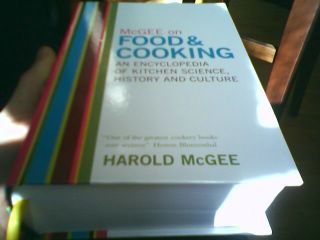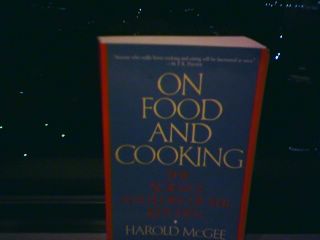i'm in tokyo this week, i didn't want to miss out writing something so i outsourced this weekend's cooking to friends; claire and simon. cooking from the avoca cookbook (avoca handweavers in ireland), they were making the raspberry chocolate tart. claire's question (to which i naturally didn't know the answer) was why do we put shortcrust pastry into the fridge after mixing it?
well, given that i'm traveling, i haven't been able to take my weighty mcgee bible with me ...

a photo of me & mcgee; happy days on our dining room floor
the size of the book would have left me with perhaps room for a pair of shoes in my luggage, so i opted for the far more reasonable mcgee on cooking 1st volume (this is only 684 pages). the decision was arrived at after an indepth analysis of the various differences between the two editions; in summary, (a) the former is not a hardback (it's a dogeared softback) and (b) the former is grey (it seems that mcgee has compensated for this fairly drab approach to colouring by opting for the clever rainbow effect of the second edition ~ i'm sure market researchers were involved somewhere along the line). other than that, i'm not certain of the difference ...

mcgee dressed casually for a night on the town in tokyo
now, for the pastry - shortcrust pastry (also called pate sucre, pate brisee) is one of 6 types of pastry (more in the future). the main reaction occurring during the making of pastry is that of protein molecules within the flour developing into gluten (a mass of molecules). too much gluten will make the pastry tough, too little will make it crumble excessively. as a disclaimer, i must quote mcgee here "our understanding of gluten is, to put it mildly, imperfect; the subject is very complicated". yes, a master of understatement, i am ever so grateful i lugged him all the way here. however, i will persevere. short pastry gets its name from the fact that we are shortening the development space & time and hence the length of the gluten chains while at the same time keeping the pastry as tender as possible ...
in researching this topic it is curious that many chefs / authors take an pro or anti-gluten view on the process. delia sits in the pro-gluten camp; http://www.deliaonline.com/cookeryschool/howto/how_0000000021.asp whereas the open university (oh yes, none other than) takes a anti-gluten view http://www.open2.net/everwondered_food/science/science_recipes14.htm. the reality is, as with most things, somewhere in the middle ... http://oregonstate.edu/instruct/nfm236/pasty/index.cfm.
shortcrust is principally made of flour, water and butter. there are 3 key elements to making the pastry; kneading, resting and cold. and the three key ingredients play a delicate role as the story unfolds (excuse the pun) ...
1. kneading the ingredients: butter is cut into the flour, it is acting to artificially shorten the length of the gluten chains by physically putting itself in the way. it is cut into the mixture in order to ensure that the maximum amount of surface is exposed to the flour. you don't overknead as you want air to be incorporated amongst the fat and the flour. water is used to fill the gaps between the flour and the butter and ensure that it binds together. therefore: pure fats are best at shortening the gluten due to the lower amount of water present (water needs to be balanced between too little (overly crumbly) and too much (gluten rich, tough pastry)).
2. resting & gluten: delia states that resting is required in order to let the gluten react with the water to develop the pastry elasticity. all pastry should be rested before rolling out. if the resting period (approx. 30mins) is not given, the pastry won't have enough stretch and will keep breaking as it is rolled. she recommends placing it in a polythene bag and into the fridge. resting time also helps to ensure that the pastry is well blended and as a result fights against shrinkage in the baked crust.
3. cold & gluten: refrigerating is required in order to ensure the butter does not get too warm while resting. if it gets too warm, it will soak into the pastry and loose its effectiveness at keeping the gluten chains apart. additionally, at higher temperatures gluten absorbs more water and develops more readily.
3.5 cold & handling: butter binds the pastry together, as it warms it will be less effective at holding the pastry in one piece. a cold pastry is far easier to handle than warm. it tends to hold its shape better and as a result can be molded into tart dishes for quiche and tarts.
from all of the above come some of the useful tips that we have today - use cold water, use metal mixing bowls, use marble boards etc.
an interesting and good rule of thumb analysis also exists:
toughener (structural enhancer): flour, egg, egg white, water & milk
tenderiser: fat, sugar, egg yolk & acid (lemon)
during the cooking blancs was on hand to point out the things that we had done wrong. it turns out that it's not generally a good idea to believe or follow pictures in cook books - if you ever see a picture of a cooked pastry tray with dough generously spilling over the edges - don't do it! best chances at producing good pastry is to mold it into the tray, roll a pin over the top to cut the edges and hold back some raw dough in order to fill in any gaps that can occur during cooking.
i've just realised that i've traveled half way around the world, brought mcgee and steingarten and stayed up in order to write this blog; this may be a phase, but i definitely am getting into food!




No comments:
Post a Comment